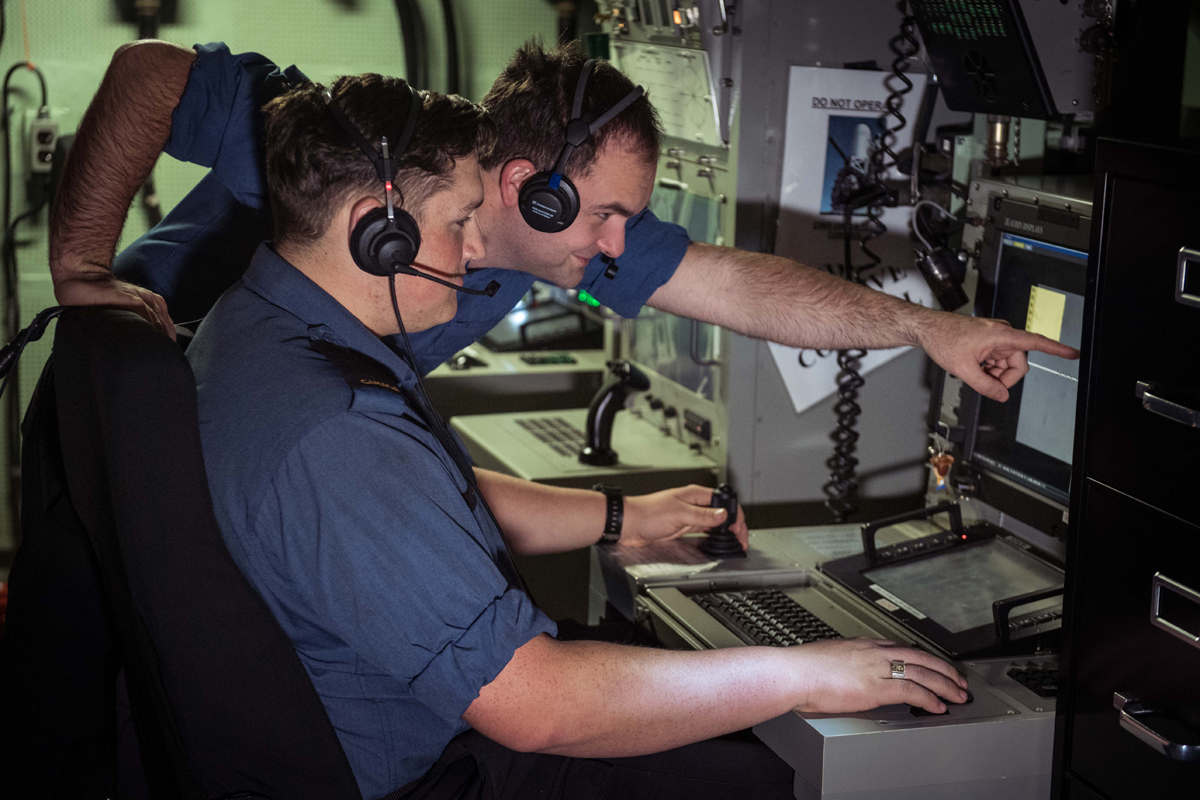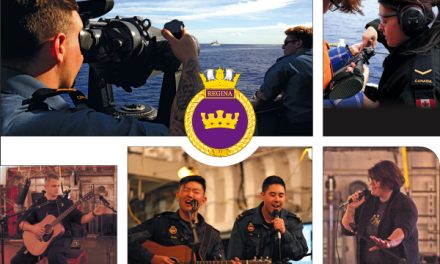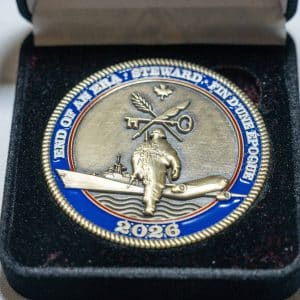
MS Firat Ataman, Forward Fire Control Supervisor, mentors OS Walker Grant as he becomes familiar with the Forward Fire Control Radar Console onboard HMCS Ottawa during Operation Projection. Photo by LS Victoria Ioganov
Captain Jenn Jackson, HMCS Ottawa PAO ~
Located two decks below the bridge of HMCS Ottawa, in a room with restricted access to maintain security of the information contained within, is the Operations Room – the central hub of the ship.
Due to the need to maintain operational security, the Operations Room (Ops Room) is cloaked in mystery for the uninitiated, as access is on an as needed basis. Contained within are dedicated sailors who maintain a 24/7 watch at sea ensuring the ship is ready to fight.
“When you think of a ship, the bridge is the eyes, the Machinery Control Room is the heart and the Operations Room is the brain,” explains Lieutenant Commander Will Chong, HMCS Ottawa Operations Officer. “All data from our sensors and communications flows to the Operations Room where it is analysed so decisions can be made determining the best course of action to support the current tactical situation.”
Divided into two sides based on function, the starboard side focuses on underwater warfare while the port side is configured to support above-water warfare. In the centre of the room is the Operations Room Officer (ORO) who has overall responsibility for running the Ops Room, working in parallel with the Officer of the Watch to maintain the operational tempo.
“The ORO is in the middle of the action, taking reports from three directors, the Ops Room Supervisor, the Officer of the Watch, and other outstations, while assessing the information, liaising with command, and then driving a plan,” says Lieutenant(N) Eric Dignard, Ottawa’s Tactics Officer and an ORO. “You have a team around you that makes sure no information goes to ground, and an Ops Room Supervisor (ORS) that makes sure everyone is on the same page. The best part is when you have a team that is as worked up as ours, where everyone knows how the other members operate, everything is just smooth, and everyone in synced up.”
A Petty Officer Second Class Naval Combat Information Operator (NCI Op), and the ORS acts as the bridge between the port, starboard and front rows to ensure the tactical picture is maintained and that the intent from the back row (the ORO and Warfare Directors) is communicated forward.
“As an ORS, you are in the middle of everything,” says Petty Officer Second Class Hugh O’Neill. “You answer to the ORO (and no one else) to ensure that everyone is, for lack of a better term, on the same song sheet.
“Directors will operate with their respective sides (port or starboard) to brief the ORO for the next course of action or plan. You have to ensure everyone is hearing and understanding what is going on. Information and reports may get missed, so you have to be aware what the procedures are and what doctrine is so you can back up the directors and especially the ORO when he briefs the Commanding Officer and takes the appropriate action.”
The starboard side of the Ops Room is the domain of the Under Water Warfare (UWW) Director. Sonar Operators working with passive and/or active sensors line the Ops Room side and report to the UWW Director, who also maintains control of firing torpedoes on command.
The port side belongs to the Above-Water Warfare (AWW) Director and includes fire control for the guns, Close-In Weapons System and Electronic Warfare. Working at the port-side systems are Naval Electronic Sensor Operators who use their equipment to keep eyes on the sky and water surrounding the ship ready to respond in a warfare scenario.
The front row NCI Ops build and maintain the common operating picture to ensure the information on the screens monitored by the ORO, directors, bridge, and ultimately the Commanding Officer accurately reflect the often quickly evolving situation.
The Ops Room is completed by the Information Management Director who operates outside of tactical operations to maintain the flow of information on and off the ship, filtering it as required to make sure relevant information is provided when needed. This role is even more crucial when the ship is working in a task group where several ships work together, all requiring a steady information flow.
With information being crucial to operations, the amount of it flowing through the Ops Rooms, particularly under the purview of the ORO, can be demanding.
“The most challenging aspect of being an ORO is balancing focussing on the current tactical picture, while managing the program, scheduling future legs of the deployment, producing external reports and progressing departmental administration,” says Lt(N) Dignard. “I often wish there were more hours in the day, but I am very fortunate that I have a reliable and engaged team around me that has facilitated this balance and can always be counted on to assist.”
These challenges are similarly echoed by the ORS.
“You have to be calm, controlled and self-disciplined during stressful scenarios and ensure the information is flowing in an orderly fashion,” adds PO2 O’Neill. “It’s very important to have ‘Operator Ears’ to pick up missed or lost information and check with the respective reporter to ensure the Director and then the ORO is aware of the developing situation.”
Despite the challenges, the one aspect of the Ops Room that shines through to any who have an opportunity to observe it is the teamwork involved and the mentorship environment which contributes to professional development – both in and out of the Ops Room.
“I can’t speak for other ships, but as an ORO in Ottawa, I have been lucky enough to have had countless command development opportunities, from having control for multiple replenishments-at-sea, along-sides and departures of foreign ports, to having control overnight while chasing VOIs (Vessels of Interest) through fishing fleets in the East China Sea during Operation Neon,” explains Lt(N) Dignard. “But really, my favorite thing about being an ORO is being part of Ottawa’s Starboard Watch Operations Team. We have been together since the start of the pre-deployment Tiered Readiness Program, and we have made it through Op Neon and Op Projection together. We have come to know how we operate and that contributes to maintaining morale and sets us up for success.”
Ottawa returned from a deployment to the Asia-Pacific region on Operation Projection Dec.18. Departing on Aug. 6, the ship and its crew conducted forward naval presence operations in the region, as well as cooperative deployments and participated in international naval exercises with partner nations. During their deployment, they also supported Operation Neon, Canada’s contribution to the enforcement of United Nations Security Council Resolutions 2375 and 2397.









